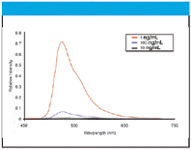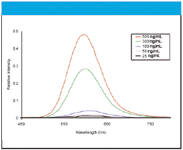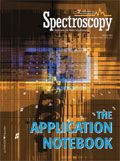DNA and Protein Concentration Measurements Using Fluorescence Analysis
Ocean Optics
The Ocean Optics Curie Spectrofluorometer is designed to measure fluorophores with excitation and emission properties across a wide 200-850 nm UV-Vis wavelength range. Our objective is to demonstrate the capabilities and sensitivity of the system in measuring DNA and protein concentration in solution using three Molecular Probes Quant-iT Assay Kits. Detection limits are reported for each kit.
The Ocean Optics Curie is a high-sensitivity cuvette emission spectrofluorometer that can detect picomolar-range concentration of fluorophores in solution from 200–850 nm.

The Curie features a CCD-array detector and is distinguished by internal linear variable filtering technology. The patented filtering helps to discriminate between powerful pulsed xenon wavelengths from the onboard excitation source and the weak spectral emissions from samples. The Curie is the only spectrofluorometer with linear variable filtering technology that can be used to spectrally shape excitation energy and eliminate the need for scanning monochromators. Each filter's transmission or blocking band can be moved throughout the 230–500 nm or 300–750 nm wavelength range.
Experimental Conditions
Three Molecular Probes Quant-iT Assay Kits were used to review the Curie's performance. The Quant-iT PicoGreen dsDNA Assay Kit (P7589) and the DNA Broad Range DNA Assay Kit (Q33130) were used to measure double-stranded DNA (dsDNA) in solution. The Quant-iT Protein Assay Kit (Q33210) was used to measure protein in solution. All working solutions and standards were prepared per the instructions provided with each kit. Sufficient volumes were prepared to allow for measurements in a standard 1-cm quartz fluorescence cuvette.
Results
Figure 1 shows the fluorescence spectrum acquired for the Pico-Green Assay Kit. Using this ultra-sensitive kit, the Curie was able to detect dsDNA to 10 ng/mL concentration at a five-second integration time. Even lower detection limits are possible with longer integration periods.

Figure 1. Fluorescence spectra acquired for the PicoGreen Assay Kit (Molecular Probes Quant-iT PicoGreen dsDNA Kit [P7589]).
Figure 2 shows the fluorescence spectra acquired for the Broad Range DNA Assay Kit. Using this kit, the Curie was able to detect dsDNA to 5 μg/mL concentration at a 1-s integration time.

Figure 2. Fluorescence spectra acquired for the Broad Range DNA Assay Kit (Molecular Probes Quant-iT Broad Range dsDNA Kit [Q33130]).
Figure 3 shows the fluorescence spectra acquired for the Protein Assay Kit. Using this kit, the Curie was able to detect protein concentration to 25 μg/mL at a 0.5-s integration time.

Figure 3. Fluorescence spectra acquired for the Protein Assay Kit (Molecular Probes Quant-iT Protein Assay Kit [Q33210]).
Conclusions
The Curie Spectrofluorometer is sensitive enough to detect the full range of fluorescence standards included in the Quant-iT DNA and Protein Assay Kits. Using the ultra-sensitive PicoGreen Assay Kit, detection limits to 10 ng/mL were achieved. This data illustrates that the Curie is capable of excitation and emission detection throughout the UV-Vis region. The Curie is a cost-effective CCD-array platform that provides a less complex alternative to more sensitive PMT-based technologies for dsDNA and protein analysis.
Ocean Optics
830 Douglas Avenue, Dunedin, FL 34698 USA
Tel. (727) 733-2447, Fax (727) 733-3962

New Study Reveals Insights into Phenol’s Behavior in Ice
April 16th 2025A new study published in Spectrochimica Acta Part A by Dominik Heger and colleagues at Masaryk University reveals that phenol's photophysical properties change significantly when frozen, potentially enabling its breakdown by sunlight in icy environments.
Tracking Molecular Transport in Chromatographic Particles with Single-Molecule Fluorescence Imaging
May 18th 2012An interview with Justin Cooper, winner of a 2011 FACSS Innovation Award. Part of a new podcast series presented in collaboration with the Federation of Analytical Chemistry and Spectroscopy Societies (FACSS), in connection with SciX 2012 ? the Great Scientific Exchange, the North American conference (39th Annual) of FACSS.
Thermo Fisher Scientists Highlight the Latest Advances in Process Monitoring with Raman Spectroscopy
April 1st 2025In this exclusive Spectroscopy interview, John Richmond and Tom Dearing of Thermo Fisher Scientific discuss the company’s Raman technology and the latest trends for process monitoring across various applications.
A Seamless Trace Elemental Analysis Prescription for Quality Pharmaceuticals
March 31st 2025Quality assurance and quality control (QA/QC) are essential in pharmaceutical manufacturing to ensure compliance with standards like United States Pharmacopoeia <232> and ICH Q3D, as well as FDA regulations. Reliable and user-friendly testing solutions help QA/QC labs deliver precise trace elemental analyses while meeting throughput demands and data security requirements.